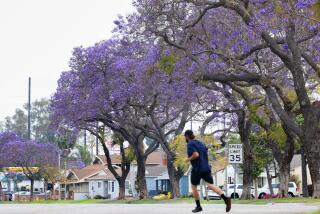The Latest Peaches
- Share via
To your ever-expanding list of this year’s tardy crops, add peaches, plums and nectarines.
The harvest so far equals only about 10% of last year’s at the same date, and all three fruits are running more than two weeks behind last year’s schedule. In tree fruit terms, that’s literally a lifetime, as that’s about how long the harvests of many varieties last.
Still, growers insist on focusing on the rainbow that’s just around the corner, rather than the rainstorm that’s getting them wet.
“You know, the real truth is, considering everything that’s going on, we’re not looking too bad,” says Gary Van Sickle, director of the California Tree Fruit Agreement near Fresno, which oversees the marketing of peaches, plums and nectarines.
For peaches and nectarines, the harvest--when it finally starts--will be almost as big as last year’s record. Expect about 270,000 tons of peaches and 260,000 tons of nectarines. Plums, which were hit by hail, will be about 180,000 tons--down about 25% from last year’s record, but only slightly below the five-year average.
“The biggest problem we’re having is with the temperature,” Van Sickle says. “It is still really cool up here. Someone figured it out, and we’re running an average of about 20 degrees cooler than normal.”
As a result, the harvest just keeps creeping along. The good news is that even if fruit isn’t getting riper, it’s still growing. This year’s fruit should be very big.
The bad news is that it takes heat to develop sugar in fruit. Though some early varieties of peaches and nectarines will begin showing up in markets in the next week, don’t judge the quality of the crop by those early samples. They’re likely to be far tarter than what we’ll get after there’s been a couple of weeks of high temperatures.
Otherwise, the big news in tree fruit land is the continuing growth of popularity in white-fleshed varieties of peaches and nectarines. Though they still make up a fairly small part of the harvest, both will be up about 50% this year over last.
Expect to see more of them at home this year, too. In the past, white-fleshed fruit has been extremely popular in Asia. With the expanding financial crisis there, marketers are refocusing their efforts on the domestic market.
*
Where did all the artichokes go? Two weeks ago they were all over the place, selling at some of the lowest prices in recent memory. Today, you’ve got to look high and low to find a few, and they cost an arm and a leg.
As we predicted, the short-term glut of ‘chokes came to a sudden end. Wholesale prices have tripled in two weeks.
The good news from Castroville is that this long, wet, mild spring has prompted some of the plants to bounce back earlier than expected. Mary Comfort of the California Artichoke Advisory Board says there might even be a brief bump in supply in July.
More to Read
Eat your way across L.A.
Get our weekly Tasting Notes newsletter for reviews, news and more.
You may occasionally receive promotional content from the Los Angeles Times.








